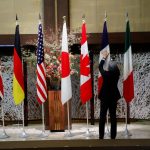
WASHINGTON (Reuters) – A U.S. proposal for using future interest on some $300 billion in frozen Russian assets to aid Ukraine, instead of seizing them outright, is gaining momentum among the Group of Seven nations, two G7 officials said.
Collateralizing the interest earned on the frozen Russian assets, which would amount to some $5 billion a year, is emerging as one of the favored options to bridge differences between the U.S. and Europe ahead of a G7 leaders summit in Italy in June.
But G7 members are still arguing about certain “holdbacks” that would whittle down those expected windfall profits to just $2.5-$3.0 billion, one of the officials said, pointing to Belgium’s 25% tax rate, a “convenience fee” applied by depository Euroclear, and a proposed litigation reserve.
G7 finance ministers will revisit the issue at a meeting in late May, with an eye to arriving at a consensus proposal to present to leaders for the June summit, the officials said.
“We feel a sense of urgency to build international consensus,” the official said. “Everyone acknowledges that we need to do more.”
A second G7 official echoed that view, underscoring the need to ensure a longer-term stream of funding for Ukraine.
A senior U.S. official said congressional approval of some $61 billion in long-delayed U.S. aid for Ukraine and a separate 50 billion euro package from the European Union would help Kyiv, but it still faced financing gaps in 2025 and 2026.
CONSENSUS
Washington continues to insist that all options – including outright seizure of Russian assets – are justified under international law and should remain on the table, but it is eager to build consensus around an idea that could help Ukraine now, the official said.
Proceeding with a loan, instead of a bond, made sense since it wouldn’t require formal issuance with a prospectus and would allow sovereign countries to act quickly, the U.S. official added. It would also allow G7 countries to provide additional support to Ukraine at relatively low cost.
The G7 comprises the United States, Canada, Japan, Britain, France, Germany and Italy.
Washington’s shift towards focusing on interest from the assets comes after its push to confiscate the assets ran into massive resistance from France, Germany and the European Central Bank, who worry that the euro could be affected if other countries such as China start repatriating their reserves as a precaution against their possible confiscation in the future.
“One big advantage of the loan idea from the European perspective is that it’s entirely focused on the windfall proceeds,” the first G7 official said. “You’re just taking the proceeds that Europe has already determined are not owned by Russia, and you’re bringing them forward. Not only is there no direct seizure, but there’s also no threat of seizure.”
Brad Setser, a senior fellow at the Council on Foreign Relations, said Washington was clearly looking for a deal, and the proposal to bring forward the anticipated interest income could provide a good basis for an agreement in June.
“It’s a very reasonable approach and has limited legal risks,” he said, noting that G7 countries had pledged to keep the Russian assets frozen until Moscow pulled its forces out of Ukraine and paid for the damages caused by the invasion.
“There’s no evidence that Russia is leaving, so that means the income stream will be available for a long period of time.”
To read the full article, Click Here

